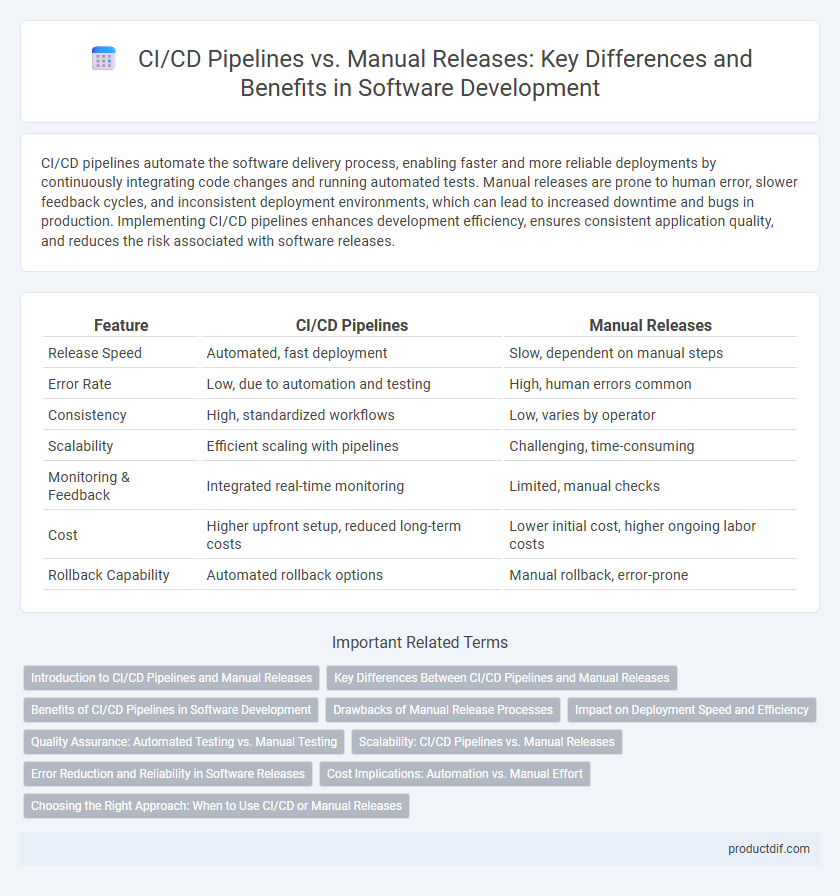CI/CD pipelines automate the software delivery process, enabling faster and more reliable deployments by continuously integrating code changes and running automated tests. Manual releases are prone to human error, slower feedback cycles, and inconsistent deployment environments, which can lead to increased downtime and bugs in production. Implementing CI/CD pipelines enhances development efficiency, ensures consistent application quality, and reduces the risk associated with software releases.
Table of Comparison
| Feature | CI/CD Pipelines | Manual Releases |
|---|---|---|
| Release Speed | Automated, fast deployment | Slow, dependent on manual steps |
| Error Rate | Low, due to automation and testing | High, human errors common |
| Consistency | High, standardized workflows | Low, varies by operator |
| Scalability | Efficient scaling with pipelines | Challenging, time-consuming |
| Monitoring & Feedback | Integrated real-time monitoring | Limited, manual checks |
| Cost | Higher upfront setup, reduced long-term costs | Lower initial cost, higher ongoing labor costs |
| Rollback Capability | Automated rollback options | Manual rollback, error-prone |
Introduction to CI/CD Pipelines and Manual Releases
CI/CD pipelines automate the software development process by integrating continuous integration and continuous deployment to deliver code changes faster and with higher quality. Manual releases rely on human intervention for testing, building, and deploying code, often leading to longer release cycles and increased risk of errors. Automation in CI/CD pipelines enhances consistency, reduces manual labor, and accelerates feedback loops compared to traditional manual release approaches.
Key Differences Between CI/CD Pipelines and Manual Releases
CI/CD pipelines automate code integration, testing, and deployment processes, ensuring faster and more reliable software releases compared to manual releases that rely heavily on human intervention and are prone to errors. Key differences include continuous integration which allows frequent code updates, automated testing that improves code quality, and automated deployment that accelerates time-to-market. Manual releases typically involve slower feedback cycles, higher risk of configuration mismatches, and increased chances of deployment failures.
Benefits of CI/CD Pipelines in Software Development
CI/CD pipelines automate the software development process, enabling faster and more reliable code integration and delivery. Automated testing within pipelines reduces human errors and ensures consistent quality across releases. Continuous deployment accelerates feedback loops, improving overall team productivity and enabling quicker response to market demands.
Drawbacks of Manual Release Processes
Manual release processes often lead to increased human errors, inconsistent deployment environments, and slower release cycles compared to automated CI/CD pipelines. These drawbacks result in prolonged downtime, reduced software quality, and higher operational costs. The lack of automation makes scalability challenging and hinders rapid feedback integration during software development.
Impact on Deployment Speed and Efficiency
CI/CD pipelines automate build, test, and deployment processes, significantly accelerating deployment speed and reducing human error compared to manual releases. Manual releases often lead to longer deployment times and increased risk of inconsistencies due to reliance on human intervention. Leveraging CI/CD tools like Jenkins, GitLab CI, or CircleCI enhances efficiency by enabling continuous integration and continuous delivery in a scalable, repeatable manner.
Quality Assurance: Automated Testing vs. Manual Testing
CI/CD pipelines integrate automated testing tools that rapidly execute numerous test cases, ensuring consistent code quality and reducing human error during releases. Manual testing, while beneficial for exploratory and usability assessments, often lacks the scalability and speed required for frequent deployments in modern software development. Automated testing frameworks within CI/CD pipelines enable early detection of defects, improving overall software reliability compared to traditional manual quality assurance processes.
Scalability: CI/CD Pipelines vs. Manual Releases
CI/CD pipelines significantly enhance scalability by automating build, test, and deployment processes, allowing teams to release software faster and more frequently without manual intervention. Manual releases often struggle to scale due to their dependency on human input, increasing the risk of errors and bottlenecks as project complexity grows. Automated pipelines support parallel workflows and continuous integration, enabling scalable software delivery in dynamic development environments.
Error Reduction and Reliability in Software Releases
CI/CD pipelines automate testing and deployment processes, significantly reducing human errors common in manual releases by ensuring consistent, repeatable workflows. Automated error detection through integrated testing frameworks enhances software reliability and accelerates the release cycle. Manual releases lack this systematic validation, increasing the risk of overlooked bugs and inconsistent deployment environments.
Cost Implications: Automation vs. Manual Effort
CI/CD pipelines significantly reduce cost implications by minimizing manual intervention, lowering labor expenses, and decreasing human error risks, which often lead to costly rollbacks and downtime. Automated pipelines enable faster feedback loops and consistent deployments, improving resource utilization and accelerating time-to-market, ultimately enhancing return on investment. Manual releases demand extensive coordination and validation, increasing overhead costs and delaying delivery, thereby making automation a more cost-effective approach for software development teams.
Choosing the Right Approach: When to Use CI/CD or Manual Releases
CI/CD pipelines automate testing, integration, and deployment, significantly reducing release time and minimizing human error, making them ideal for frequent, iterative updates in agile environments. Manual releases offer greater control and customization, suitable for complex deployments, low-frequency releases, or mission-critical applications requiring thorough oversight. Companies should evaluate factors such as release frequency, team expertise, testing maturity, and risk tolerance to determine whether CI/CD automation or manual release processes better align with their development workflow and business goals.
CI/CD Pipelines vs Manual Releases Infographic

 productdif.com
productdif.com